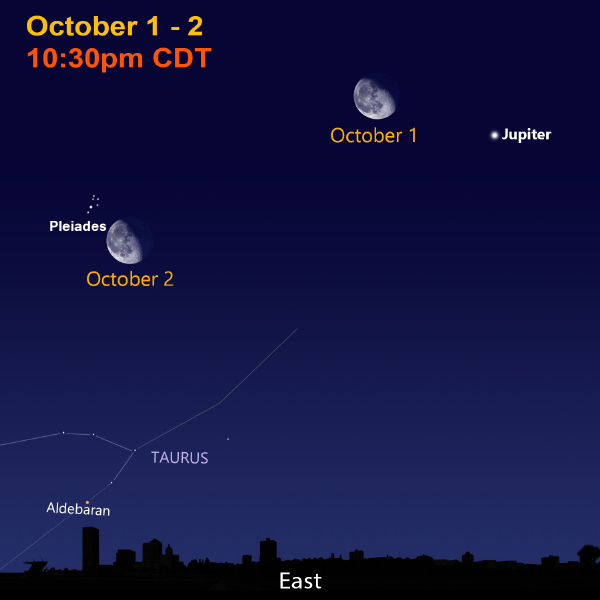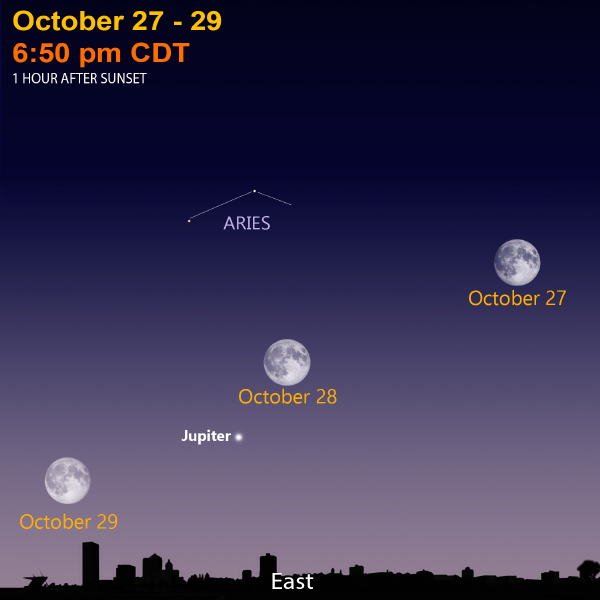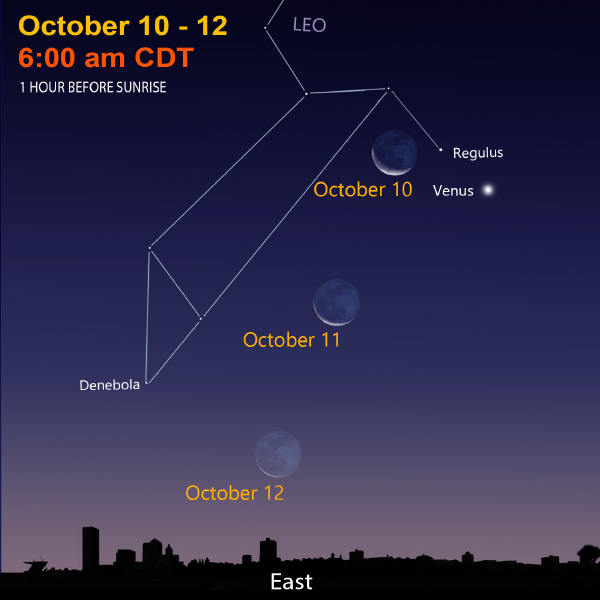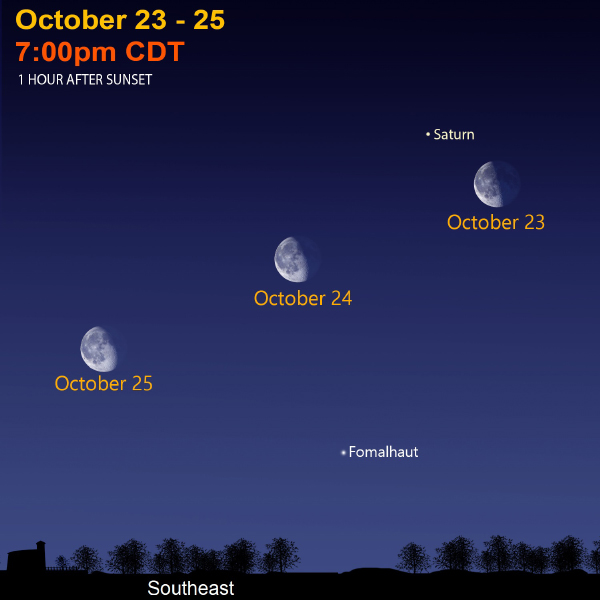Cosmic Curiosities
"If the dinosaurs had had a space program, they would not be extinct."
- Carl Sagan, American Astronomer
Asteroid Answers
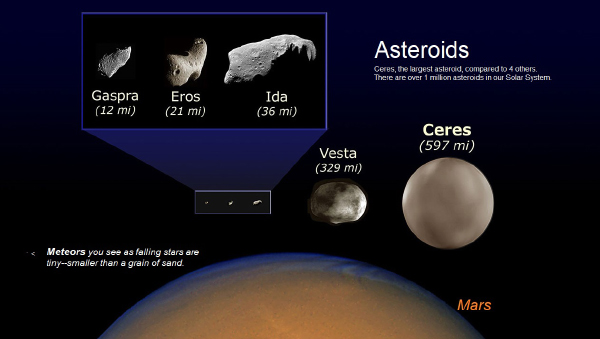
1. WHAT IS AN ASTEROID?
It’s a rock in space. Their sizes can range from hundreds of miles across to only three feet. They are not big enough to be planets. However, most are gargantuan compared to meteors, which are typically smaller than grains of sand.
Ceres was the largest asteroid at almost 600 miles in diameter; it became a dwarf planet in 2006. This rock is big enough so its gravity can pull itself into a round shape.
2. WHAT IS THE DIFFERENCE BETWEEN A COMET AND AN ASTEROID?
Ice! Both started long ago with the start of the solar system, but asteroids formed much closer to the sun, so most of the frozen water sublimated (turned into gas). Comets came together at the outskirts of the solar system—think Pluto and beyond. Temperatures are crazy cold out here, about 400 degrees below zero. Sometimes comets do venture close to the sun where their ice and dust make cool tails.
3. WHAT IS A NEAR-EARTH OBJECT (NEO)?
Near-Earth Objects (NEOs) are comets and asteroids that enter the Earth’s neighborhood. They get nudged by gravity from nearby planets and enter our realm. NASA keeps a close eye on these potentially dangerous objects. They have discovered more than 90% of the NEOs that are larger than one kilometer.
Back in May 2023, an asteroid 120-feet across came within 4 million miles of Earth—that is 16 times the distance of the moon.
4. HAS NASA VISITED AN ASTEROID?
Yes! NASA has visited a handful of asteroids and taken some awesome pictures. Still, this is a tiny amount of the million asteroids known to exist. In fact, did you know NASA just brought part of an asteroid back to Earth? And they are launching a mission to another asteroid very soon!
Osiris Rex Mission to Asteroid Bennu—Captures Sample 2020, Returns to Earth 2023
The OSIRIS-Rex collected a small part of asteroid Bennu in 2020. It took three years, but it returned to Earth in the Utah desert just a week ago on September 24, 2023. The rocks will give astronomers a view of the origins of the solar system 4.5 billion years ago.
Mission to Asteroid Psyche—Launches 2023, Arrives 2029
On October 5, 2023, NASA will launch a new spacecraft to the asteroid Psyche, a unique metal-rich asteroid between Mars and Jupiter. It will fly by Mars in 2026, arrive at the asteroid in 2029, and orbit there for two years.
5. WHAT DOES THE WORD “ASTEROID” MEAN?
It means “star-like” or “kind of a star.” When the first four asteroids were discovered back in the early 1800s, astronomers saw them as dots of light in their telescopes. They first called them planets. But since they were not very big—and no one could see them with the naked eye—the word asteroid was finally chosen for their name.
The first asteroids discovered were Ceres in 1801, Pallas in 1802, Juno in 1804, and Vesta in 1807.
Ring of Fire
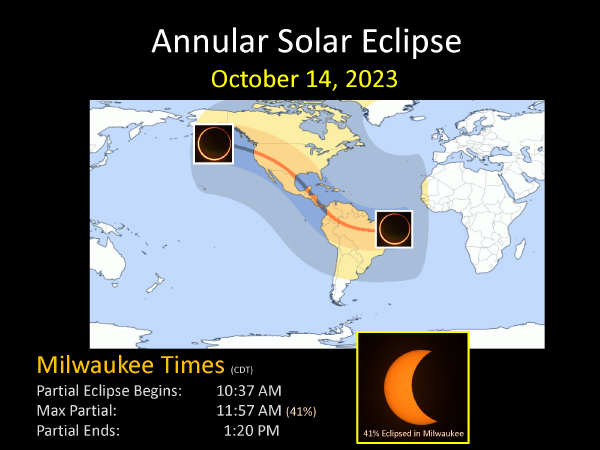
On Saturday, October 14, 2023, a slightly smaller moon lines up with the sun, creating an annular eclipse. I love the “ring of fire” nickname for this rare event. Strange, though; I have never seen one. I’ve been fortunate to witness totality six times, but never an annular solar eclipse. This time, I will be heading west to Oregon to hopefully see the sun 99% eclipsed. Crossing my fingers for clear skies! Everyone in America—including Alaska and Hawaii—will see a partial solar eclipse. The annular path runs from Oregon to Texas and then to South America.
Here in Milwaukee, the moon will block 41% of the sun. The Sun needs to be about 80% eclipsed for people to notice some sky darkening. Here at MPM, we will have telescopes available to the public:
PARTIAL SOLAR ECLIPSE: PUBLIC VIEWING!
Clear skies permitting!
When: Saturday, October 14, 10:30 a.m. to 1 p.m. CDT
Where: Milwaukee Public Museum, outside the Daniel M. Soref Planetarium, by the Green Clock on Wells Street
What: Telescopes with a safe solar filter will be available. Safe eclipse glasses will be available for sale for $2.
Exact Eclipse Times:
- 10:37 a.m. - Moon starts to move in front of sun
- 11:57 a.m. - Maximum eclipse for Milwaukee -- 41% of sun will be eclipsed
- 1:20 p.m. - Eclipse ends
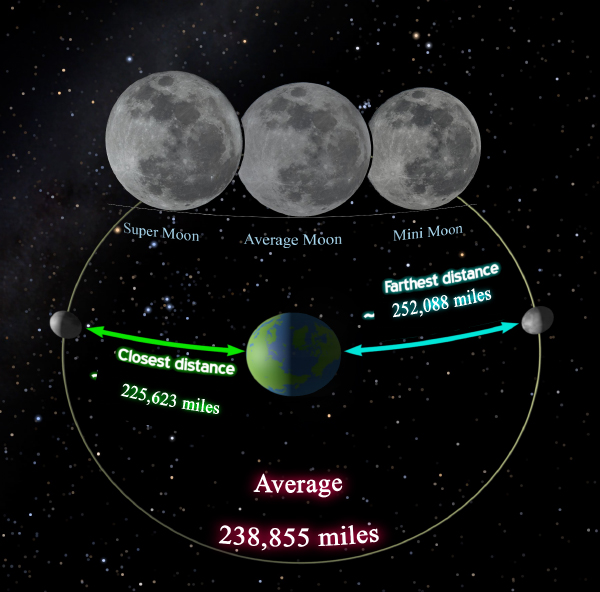
The reason the moon is smaller and will not totally block the sun is due to its elliptical orbit. At mini moon (opposite of a super moon), it is a little further away from Earth and thus appears smaller in the sky.
Below is a chart that shows the percentages of the various solar eclipses. Please note: This does not mean that the next solar eclipse coming to your city has a 31% chance of being a total one—when the moon completely blocks the sun. It means you probably must travel to see totality. If you don’t travel, your chance of seeing totality is one time every 400 years! The last one in Milwaukee was 1379. The next one occurs in 2099!
| Solar Eclipses: 1901 - 2000 | ||
|---|---|---|
| Eclipse Type | Number | Percent |
| All Eclipses | 228 | 100.0% |
| Partial | 78 | 34.2% |
| Annular | 73 | 32.0% |
| Total | 71 | 31.1% |
| Hybrid—Annular & Total | 6 | 2.6% |
Not from Milwaukee? Go to the Time & Date website and enter your city to see how much of the sun will disappear in your sky. Or contact your local planetarium!
Halloween Night
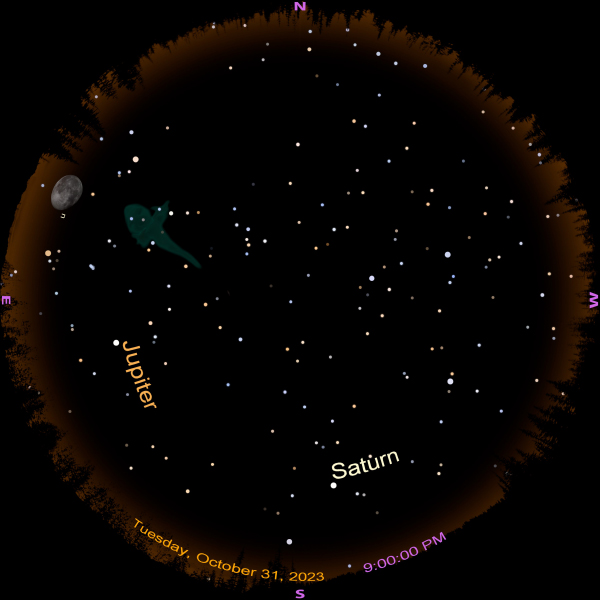
Jupiter and Saturn shine in the south this Halloween. A waning gibbous moon (three days past full) rises just before 9 p.m. What else might frolic above?
The date of Halloween is an astronomical holiday. It has to do with seasons. October 31 is a "cross-quarter date," approximately halfway between an equinox and a solstice. There are four cross-quarter dates throughout the year: Groundhog Day (Feb. 2), May Day (May 1), Lammas Day (Aug. 1), and Halloween (Oct. 31).
Long ago, the Celts of the British Isles used cross-quarter days to mark the beginnings of seasons. Halloween is the start of winter. They called it Samhain. This makes sense because by the end of October we really notice how the dark nights dominate—and how cold it’s already getting—especially for north latitudes. Centuries later, Samhain became associated with All Saints Day on November 1. Halloween means “All Hallow’s Eve,” when spirits of the dead wander from sunset until midnight. After that, on November 1, the ghosts are said to go back to rest.
Space in Sixty Seconds
Check out the partial solar eclipse and this year’s Halloween night sky!
Sky Sights
Stay up a little late and catch bright Jupiter and the Moon shining together on the mornings of October 1-2 and again—from October 27-29!
Venus dominates the morning sky east in the constellation Leo, though there’s competition from the bright stars of Orion and his dog stars to the south. Spot a crescent Moon orbiting by from October 10-12.
Spot Saturn in the southeast after sunset. Give yourself a challenge and locate the bright star Fomalhaut much lower in the SE sky. The Moon shines near Saturn from October 23-25.
Mercury and Mars are too close to the sun to be seen this October.
October Star Map
Sign Up
Receive this newsletter via email!
Subscribe
See the Universe through a telescope
Join one of the Milwaukee-area astronomy clubs and spot craters on the Moon, the rings of Saturn, the moons of Jupiter, and much more.
Follow Bob on social media
Twitter: @MPMPlanetarium
Facebook: Daniel M. Soref Planetarium


